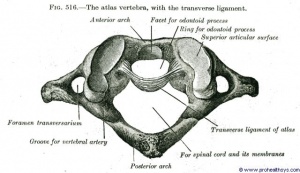Transverse Ligament Stress Test: Difference between revisions
No edit summary |
No edit summary |
||
| Line 1: | Line 1: | ||
<div class="editorbox"> | <div class="editorbox"> | ||
'''Original Editor '''- | '''Original Editor '''- [[User:Tamara Eller|Tamara Eller]] and [[User:Audrey Pittman|Audrey Pittman]] | ||
'''Lead Editors''' - Your name will be added here if you are a lead editor on this page. [[Physiopedia:Editors|Read more.]] | '''Lead Editors''' - Your name will be added here if you are a lead editor on this page. [[Physiopedia:Editors|Read more.]] | ||
| Line 18: | Line 18: | ||
*A positive test is the reoccurance of symptoms: | *A positive test is the reoccurance of symptoms: | ||
#Abnormal pupil response | #Abnormal pupil response | ||
#Eye twitching or nystagmus | #Eye twitching or nystagmus | ||
#Soft end feel | #Soft end feel | ||
#Muscle spasm | #Muscle spasm | ||
#Dizziness | #Dizziness | ||
#Nausea | #Nausea | ||
#Paresthesia of the lip face or limb | #Paresthesia of the lip face or limb | ||
#Lump sensation in the throat. | #Lump sensation in the throat. | ||
| Line 51: | Line 51: | ||
<references /> | <references /> | ||
[[Category:Articles]] [[Category:Assessment]] [[Category:Cervico-Thoracic]] [[Category:Musculoskeletal/Orthopaedics]] [[Category:Special Tests]] [[Category:Videos]] | |||
Revision as of 22:08, 4 June 2009
Original Editor - Tamara Eller and Audrey Pittman
Lead Editors - Your name will be added here if you are a lead editor on this page. Read more.
Purpose
[edit | edit source]
Test for hypermobility of the atlantoaxial articulation.
Technique [1][edit | edit source]
- The patient is placed in a supine postion with the Therapist supporting the patient's head with the palms and 3rd-5th fingers.
- The Therapist then places the index fingers between the occiput and spinous process of C2, so the index fingers are over the neural arch of the C1 vetebra.
- The Therapist then lifts the patients head and C1 vetebra anteriorly, without allowing flexion or extension.
- The position should be held for 10-20 seconds.
- A positive test is the reoccurance of symptoms:
- Abnormal pupil response
- Eye twitching or nystagmus
- Soft end feel
- Muscle spasm
- Dizziness
- Nausea
- Paresthesia of the lip face or limb
- Lump sensation in the throat.
| [2] |
Evidence[edit | edit source]
Provide the evidence for this technique here
Resources[edit | edit source]
Pettman E: Stress tests of the craniovertebral joints. In: Boyling, JD, Palastanga N, eds. Grieve's Modern Manual Therapy: The Vertebral Column, 2nd edn. Edinburgh: Churchill Lingstone, 1994:529-538.
Recent Related Research (from Pubmed)[edit | edit source]
Failed to load RSS feed from http://eutils.ncbi.nlm.nih.gov/entrez/eutils/erss.cgi?rss_guid=1ve5_AlTrKTWE44YJCO4KKVKhs8AGgl9QnItdi_j7eNnng25m|charset=UTF-8|short|max=10: Error parsing XML for RSS
References[edit | edit source]
References will automatically be added here, see adding references tutorial.
- ↑ ↑ Dutton, M. (2008). Orthopaedic: Examination, evaluation, and intervention (2nd ed.). New York: The McGraw-Hill Companies, Inc.
- ↑ online video,http://www.youtube.com/watch?v=GN-yvAYFIig, last accessed 06/04/09







